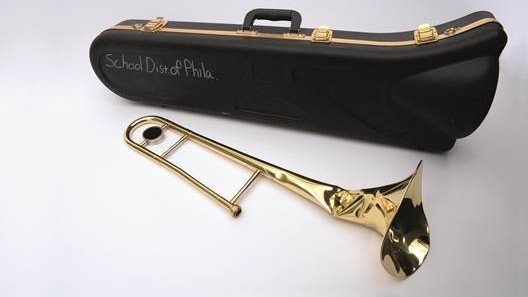
Deep funding cuts to public school programs is forcing districts around the US to reduce or even eliminate arts education. The Philadelphia school system is no exception. Its once robust music program has been struggling because a large number of the instruments are damaged, with no funds to repair get them. Now, thanks to “Symphony for a Broken Orchestra,” an initiative spearheaded by Temple Contemporary, some of the wounded cellos, violins, and trumpets are getting a new lease on life.
The idea came about in 2013 when Temple Contemporary Director Richard Blackson was touring one of the 23 Philadelphia schools that had been closed that year. Among the items being consolidated from all the shuttered schools was a room full of broken instruments. Working with Frank Machos, the arts director of the School District of Philadelphia, Blackson painstakingly examined and cataloged each wounded horn, woodwind, and stringed instrument and found that 1,000 of them were repairable.

To help raise funds for the project, he reached out to Pulitzer and Grammy-winning composer David Lang. “I’m completely a product of the public schools. So when [Blackson] told me he had access to these 1,000 instruments, my first thought was that each one of these instruments was an opportunity to change the life of a student that wasn’t going to happen,” said Lang. The talented musician, who was nominated for an Academy Award in 2015, came up with the brilliant idea of writing a symphony specifically for the sounds emanated by the damaged instruments, many of which were held together by tape or had to be carried in multiple segments.
With a grant from the Pew Center For Arts & Heritage, the aptly named “Symphony for a Broken Orchestra” debuted at Philadelphia’s 23rd Street Armory on December 3, 2017. Performed by 400 musicians, who ranged in age from 8 to 83, the melodies, which drew on Lang’s traditionally minimalist style, were a powerful testament to what rusty French horns or string-less cellos could do.
“It teaches you a lesson and breaks you out of the box. You can learn music in an untraditional way and see that it doesn't need to just be in an orchestra,” said Evelyn Mitka, a 16-year-old from the Philadelphia High School for Creative & Performing Arts. Her violin lacked an A string and bridge, while her bow had almost no hair.

The effort, which brought the issue to light and raised much-needed funds, did not end with the performance. The “Symphony for a Broken Orchestra” project continues online with a profile of all the broken instruments and snippets of their role in the December 3 performance, even if that’s just the clacking of keys. Donors can “adopt” one or more instruments by contributing between $50 to $200.
Thanks to this project, which has thus far raised over $237,000, Philadelphia students will find working instruments when they return to school this fall. Inside every case will be a story about how the wounded device was brought back to life. Hopefully, the success of this unusual endeavor will inspire public school districts around the country to come up with innovative ways to keep their rapidly-disappearing arts programs alive.
Resources: symphonyforbrokenorchestra.org,npr.org, project440.org
